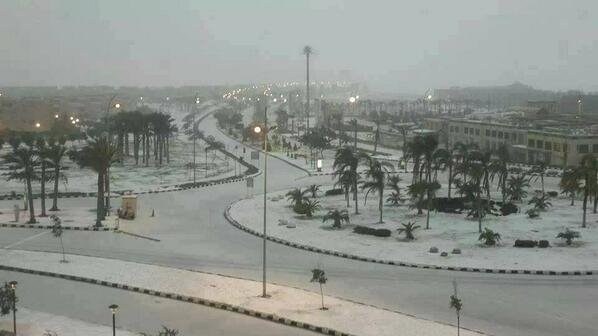In February of 1972 earth-orbiting artificial satellites revealed the existence of a greatly increased area of the snow and ice cover of the north polar cap as compared to all previous years of space age observations. Some scientists believe that this may have presaged the onset of the dramatic climate anomalies of 1972 that brought far-reaching adversities to the world's peoples. Moreover, there is mounting evidence that the bad climate of 1972 may be the forerunner of a long series of less favorable agricultural crop years that lie ahead for most world societies. Thus widespread food shortages threaten just at the same time that world populations are growing to new highs. Indeed, less favorable climate may be the new global norm. The Earth may have entered a new "little ice age". (emphasis added).Starvation was the scare tactic back then, as coastal flooding is now. Too much rain and not enough, too hot weather and too cold, all were linked to climate change.
Hot, dry weather in July and August of 1972 devastated food crops in the Soviet Union in the Moscow region. This was preceded by unusually cold and severe growing conditions in the Ukraine for winter wheat. The Soviet Union, as a consequence, purchased over 25 million metric tons of grain abroad. In the same year, India's monsoon rains came one to two weeks late, and retreated early. This materially reduced India's cereal production.
The South Sahara (Sahel) drought worsened. Inadequate rains damaged grain production in Argentina and Australia. Peru's anchovy catch, a major Latin American protein resource, dropped drastically, though it is not certain that this was the result of a climate change. Abnormally wet weather, clearly a climate anomaly, in the fall of 1972 and into the spring of 1973 reduced U.S. production of corn and soybeans.
Reflecting all this, world food prices skyrocketed as world grain reserves dwindled. By the start of 1974 corn and wheat prices had doubled or tripled, as compared to a mere two years before. Many countries of the world are now experiencing serious waves of inflation; most economists consider the food cost spiral to be a significant contributing cause. There are strong signs that these recent climate disasters were not random deviations from the usual weather, but instead signal of the emergence of a new normal for world climates. If so, it is a normal that will be far less favorable to global agriculture, and thus to world food supplies. (emphasis added).
I had never heard of climatologists back then, but they predicted that global cooling was leading to just about everything that's linked to global warming forty years later.
The arguments for this view were developed by several of the climatologists who attended an international workshop on climate and its effects on human life convened in May 1974 in Bonn, Germany. At this meeting Profs. H. Flohn of Germany, H.H. Lamb of the United Kingdom and Reid Bryson of the United States developed a highly persuasive demonstration that there has been a steady cooling of northern hemisphere temperatures during the last 30 years, with the strongest cooling at the higher latitudes. The average cooling has been only about 0.3°C, but this appears to be sufficient to cut about one week from the mid-latitude growing season, a highly significant matter agriculturally. Even more important, however, such a cooling appears, these climatologists believe, to be accompanied by a more variable climate, with agriculturally adverse droughts, abnormally cold spells, heat waves, and other extremes becoming more common. (emphasis added).
In more recent news on this Friday the 13th, the year 2013, the Middle East is blanketed in snow, as not seen in more than a century.
CAIRO -- Snow coated domes and minarets Friday as a record Middle East storm compounded the suffering of Syrian refugees, sent the Israeli army scrambling to dig out stranded motorists and gave Egyptians a rare glimpse of snow in their capital.
Nearly three feet of snow closed roads in and out of Jerusalem, which is set in high hills, and thousands in and around the city were left without power. Israeli soldiers and police rescued hundreds trapped in their cars by snow and ice. In the West Bank, the branches of olive trees groaned under the weight of snow.
In Cairo, where local news reports said the last recorded snowfall was more than 100 years ago, children in outlying districts capered in white-covered streets, and adults marveled at the sight, tweeting pictures of snow-dusted parks and squares. In other parts of the city, rain and hail rocketed down.
http://www.latimes.com/world/worldnow/la-fg-wn-snow-israel-egypt-20131213,0,1691393.story#ixzz2nPCYVXOb
Hebron
Israeli soldiers patrol in the snowy city center of the West Bank town of Hebron.
http://www.latimes.com/la-wn-snow-middle-east-pictures,0,4657856.photogallery#ixzz2nPFq5Xiu |
 |
| Vehicles are see stranded in the snow in Jerusalem on December 13, 2013. AFP PHOTO/AHMAD GHARABLI |
 |
| Some reports suggest it’s the first snow in Cairo in over 100 years – although they are not substantiated. |
Meanwhile, here in Bozeman we've experienced an abnormally frigid December, including a 5 day stretch were highs failed to exceed zero degrees and lows into the negative 20's. After four or five days of normal temperatures to come, the deep freeze is expected to return by Thursday next week.
No comments:
Post a Comment